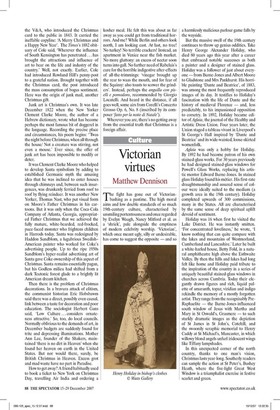Victorian virtues
Matthew Dennison rr he fight has gone out of Victorian1 bashing as a pastime. The high moral aims and low double standards of so much 19th-century culture, characterised by unsmiling portentousness and once regarded by Evelyn Waugh, Nancy Mitford et al. as a 'shriek', pale alongside the emptiness of modern celebrity worship. 'Victorian', which once meant ugly, silly or undesirable, has come to suggest the opposite — and so a harmlessly malicious parlour game falls by the wayside.
But the massive swell of the 19th century continues to throw up genius oddities. Take Henry George Alexander Holiday, who died 80 years ago this year after a career that embraced notable successes as both a painter and a designer of stained glass. Holiday was a follower of just about everyone — from Burne-Jones and Albert Moore to Gladstone and Mrs Pankhurst. His horrible painting 'Dante and Beatrice', of 1883, was among the most frequently reproduced images of its day. It testifies to Holiday's fascination with the life of Dante and the history of medieval Florence — and, less predictably, to his impassioned opposition to corsetry. In 1892, Holiday became editor of Aglaia, the journal of the Healthy and Artistic Dress Union. Four years later, the Union staged a tableau vivant in Liverpool's St George's Hall inspired by 'Dante and Beatrice' and its wide-waisted, loose-skirted womenfolk.
Aglaia was only a hobby for Holiday. By 1892 he had become patron of his own stained-glass works. For 30 years previously he had designed stained-glass windows for Powell's Glass Works, replacing his artistic mentor Edward Burne-Jones. In stained glass Holiday found his métier. His first-rate draughtsmanship and assured sense of colour were ideally suited to the medium (a growth area in the 19th century). Holiday completed upwards of 300 commissions, many in the States. All are characterised by the same sense of deep spiritual uplift devoid of sentiment.
Holiday was 16 when first he visited the Lake District. He was instantly smitten. Tor concentrated loveliness,' he wrote, 'I know nothing that can quite compare with the lakes and mountains of Westmorland, Cumberland and Lancashire.' Later he built a white-harled house, Betty Fold, in a natural amphitheatre high above the Esthwaite Valley. By then the hills and lakes had long felt like home and Holiday paid tribute to the inspiration of the country in a series of uniquely beautiful stained-glass windows in churches across Cumbria. Today their elegantly drawn figures and rich, liquid palette of amaranth, topaz, viridian and indigo rekindle the memory of a mostly forgotten artist. They range from the recognisably PreRaphaelite — the Burne-Jones-influenced south window of Jesus with Martha and Mary in St Oswald's, Grasmere — to such starkly dramatic images as the depiction of St James in St John's, Cotehill, and the swoonily seraphic memorial to Henry Caddy at St Michael's, Muncaster, in which willowy blond angels unfurl iridescent wings like Tiffany lampshades.
In this unexpected corner of the north country, thanks to one man's vision, Christmas lasts year-long. Southerly readers can sample the action at St Peter's, Bushey Heath, where the five-light Great West Window is a triumphalist exercise in festive scarlet and green.

































































































 Previous page
Previous page